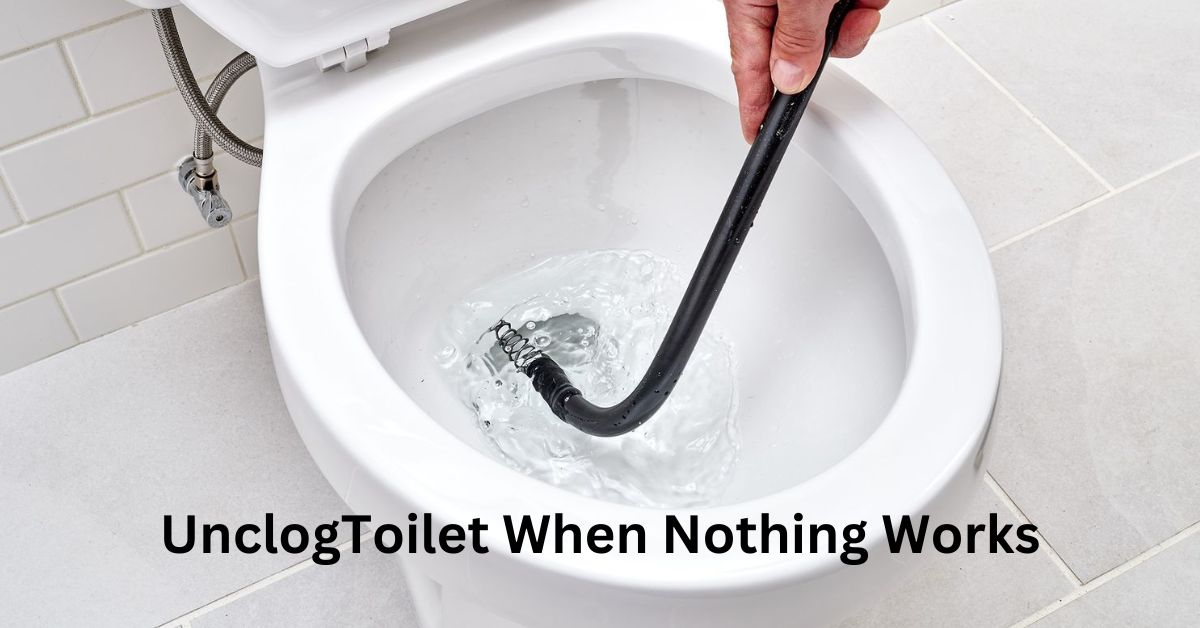Introduction: Dealing with a clogged toilet can be a frustrating and unpleasant experience. Sometimes, standard plunging and basic unclogging techniques may not be enough to resolve the issue. In this article, we’ll explore ten effective methods to how to unclog toilet when nothing works when nothing else seems to work. By following these steps, you’ll be able to tackle even the most challenging clogs and restore your toilet’s functionality.
- Plunger Technique: Start with a plunger specifically designed for toilets. Create a tight seal around the drain and plunge vigorously, aiming for a strong push-pull motion. Repeat this process several times to dislodge the clog.
- Hot Water Method: Boil a pot of water and carefully pour it into the toilet bowl from waist height. The hot water can help dissolve and break down the blockage. Let it sit for a few minutes before attempting to flush.
- Baking Soda and Vinegar: Mix one cup of baking soda with one cup of vinegar. Pour the mixture into the toilet bowl and let it sit for around 30 minutes. Then, flush with hot water to clear the clog.
- Dish Soap and Hot Water: Squirt a generous amount of dish soap into the toilet bowl. Follow it up with a pot of hot (not boiling) water. Allow the combination to sit for a while, and then try flushing.
- Wire Hanger: Straighten out a wire hanger, leaving the hook intact. Insert the wire into the toilet drain and gently push, twist, and maneuver it to break up the clog. Be cautious not to scratch the toilet bowl.
- Plumbing Snake: If you have a plumbing snake (also known as a drain auger), insert it into the toilet drain and rotate the handle clockwise. Push the snake forward until you feel resistance, then twist and pull to dislodge the clog.
- Wet/Dry Vacuum: If you have a wet/dry vacuum, set it to vacuum up liquids. Create a tight seal around the toilet drain with the hose attachment and turn on the vacuum. This method can be highly effective in removing stubborn clogs.
- Enzyme-Based Cleaners: Enzyme-based cleaners can help break down organic waste and clogs. Follow the instructions on the product packaging to use the cleaner effectively. Allow the recommended time for the enzymes to work before attempting to flush.
- Caustic Soda (Sodium Hydroxide): Take precautionary measures such as wearing gloves and eye protection before using caustic soda. Add three cups of caustic soda to the toilet bowl, followed by a gallon of hot water. Allow it to sit for 20-30 minutes before flushing.
- Call a Professional: If all else fails, it may be time to call a professional plumber. They have the expertise, tools, and experience to handle even the most stubborn toilet clogs safely and efficiently.
Conclusion: A clogged toilet can be a nuisance, but don’t despair when traditional methods fail. Try the techniques outlined in this article, such as plunging, using hot water, or employing household items like baking soda, vinegar, or dish soap. For more stubborn clogs, utilize tools like wire hangers, plumbing snakes, or wet/dry vacuums. Remember to exercise caution when using caustic soda or seek professional assistance when needed. With these effective methods, you’ll have a clear and functioning toilet in no time.
FAQs
Q: What should I do if the toilet is still clogged after using the plunger?
A: If the plunger doesn’t work, try using a combination of hot water and dish soap. Squirt a generous amount of dish soap into the toilet bowl and follow it up with hot (not boiling) water. Allow it to sit for a while, and then attempt to flush again.
Q: What if the clog is too stubborn for hot water and dish soap?
A: If hot water and dish soap doesn’t work, consider using a plumbing snake or a wire hanger. Insert the snake or hanger into the toilet drain and gently push, twist, and maneuver to break up the clog. Exercise caution to avoid damaging the toilet bowl.
Q: Are there any commercial products I can use to unclog a toilet?
A: Yes, there are several commercial products available, such as enzyme-based cleaners or caustic soda (sodium hydroxide). Follow the instructions on the product packaging carefully and allow sufficient time for the product to work before attempting to flush.
Q: What if none of the DIY methods work?
A: If none of the DIY methods prove successful, it may be time to call a professional plumber. They have the expertise and specialized tools to handle tough clogs safely and effectively.
Q: How can I prevent future toilet clogs?
A: To prevent future clogs, be mindful of what you flush down the toilet. Avoid flushing excessive toilet paper, feminine hygiene products, wipes, or any other items that are not designed to dissolve easily. Additionally, regular maintenance, such as periodic plunging or using enzymatic cleaners, can help keep your toilet drain clear.
Q: Is there anything else I can try before calling a plumber?
A: If you haven’t already tried all the DIY methods mentioned earlier, you can attempt using a wet/dry vacuum or a combination of baking soda and vinegar. These methods might provide an effective solution before resorting to professional help.
Remember, if you are unsure or uncomfortable performing any of these methods, it is best to seek the assistance of a professional plumber to avoid causing further damage to your toilet.
Read This: How to Turn off Tesla While Inside
